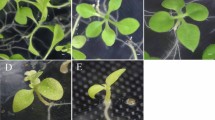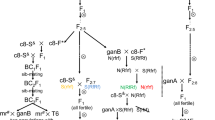Abstract
Hybrid lethality, a type of postzygotic reproductive barrier, is important for species. Discovering novel hybrid lethality cases and analyzing corresponding causal genes may provide new insights into the establishment and maintenance of reproductive isolation. In this study, we observed the hybrid lethality phenomena in a cross between two cabbage inbred lines, 09-211 and 09-222. Genetic analysis revealed that the hybrid lethality was controlled by two complementary dominant genes, BolC.HL1.a and BolC.HL2.a, from 09-211 and 09-222, respectively. Further analysis indicated that the two genes conform to the Bateson-Dobzhansky-Muller model. Fine mapping of hybrid lethal genes revealed that BolC.HL1.a was located on the C01 chromosome by Indels HL132 and HL134, with a genetic distance of 0.2 and 0.1 cM, respectively. The interval distance between the two markers was 101 kb. BolC.HL2.a was fine-mapped on the C04 chromosome by HL235 and HL234 at a distance of 0.3 and 0.3 cM, respectively. The physical distance was 70 kb. These findings lay the foundation for cloning the hybrid lethality genes in the future and contribute to our understanding of the molecular and evolutionary mechanisms of hybrid lethality in Brassica oleracea.




Similar content being viewed by others
References
Barbash DA, Siino DF, Tarone AM, Roote J (2003) A rapidly evolving MYB-related protein causes species isolation in Drosophila. Proc Natl Acad Sci USA 100(9):5302–5307
Bomblies K, Weigel D (2007) Hybrid necrosis: autoimmunity as a common barrier to gene-flow in plants. Nat Rev Genet 8:382–393
Bomblies K, Lempe J, Epple P, Warthmann N, Lanz C, Dangl JL, Weigel D (2007) Autoimmune response as a mechanism for a Dobzhansky–Muller-type incompatibility syndrome in plants. PLoS Biol 5(9):1962–1972
Brideau NJ, Flores HA, Wang J, Maheshwari S, Wang X, Barbash DA (2006) Two Dobzhansky–Muller genes interact to cause hybrid lethality in Drosophila. Science 314:1292–1295
Brown MS, Menzel MY (1952) Additional evidence on the crossing behavior of Gossypium gossypioides. Bull Torrey Bot Club 79(4):285–292
Caldwell RM, Compton LE (1943) Complementary lethal genes in wheat: causing a progressive lethal necrosis of seedlings. J Hered 34:67–70
Chae E, Bomblies K, Kim ST, Karelina D, Zaidem M, Ossowski S, Martín-Pizarro C, Laitinen RAE, Rowan BA, Tenenboim H, Lechner S, Demar M, Habring-Müller A, Lanz C, Rätsch G, Weigel D (2014) Species-wide genetic incompatibility analysis identifies immune genes as hot spots of deleterious epistasis. Cell 159(6):1341–1351
Chen C, Zhuang M, Li K, Liu Y, Yang L, Zhang Y, Chen F, Sun P, Fang Z (2010) Development and utility of EST-SSR marker in cabbage. Acta Hortic Sin 37(2):221–228 (in Chinese)
Chu YE, Oka HI (1972) The distribution and effects of genes causing F1 weakness in Oryza breviligulata and O glaberrima. Genetics 70:163–173
Chu CG, Faris JD, Friesen TL, Xu SS (2006) Molecular mapping of hybrid necrosis genes Ne1 and Ne2 in hexaploid wheat using microsatellite markers. Theor Appl Genet 112:1374–1381
Coyne JA, Orr AH (2004) Speciation. Sinauer Associates Inc, Sunderland
Deverna JW, Myers JR, Collins GB (1987) Bypassing prefertilization barriers to hybridization in Nicotiana using in vitro pollination and fertilization. Theor Appl Genet 73:665–671
Dobzhansky TH (1937) Genetics and the origin of species. Columbia University Press, New York
East EM (1935) Genetic reactions in Nicotiana. I. compatibility. Genetics 20:0403–0413
Hollingshead LA (1930) A lethal factor in Crepis effective only in an interspecific hybrid. Genetics 15:114–140
Ichitani K, Fukuta Y, Taura S, Sato M (2001) Chromosomal location of Hwc2, one of the complementary hybrid weakness genes, in rice. Plant Breed 120:523–525
Ichitani K, Namigoshi K, Sato M, Taura S, Aoki M, Matsumoto Y, Saitou T, Marubashi W, Kuboyama T (2007) Fine mapping and allelic dosage effect of Hwc1, a complementary hybrid weakness gene in rice. Theor Appl Genet 114:1407–1415
Inoue E, Sakuma F, Kasumi M, Hara H, Tsukihashi T (2003) Effect of high-temperature on suppression of the lethality exhibited in the intergeneric hybrid between Japanese pear (Pyrus pyrifolia Nakai) and apple (Malus × domestica Borkh.). Sci Hortic 98:385–396
Jeuken MJW, Zhang NW, Mchale LK, Pelgrom K, den Boer E, Lindhout P, Michelmore RW, Visser RG, Niks RE (2009) Rin4 causes hybrid necrosis and race-specific resistance in an interspecific lettuce hybrid. Plant Cell 21:3368–3378
Kosambi DD (1943) The estimation of map distances from recombination values. Ann Eugen
Kostoff D (1930) Ontogeny, genetics and cytology of Nicotiana hybrids. Genetica 12:33–139
Liu R, Meng J (2003) Map draw: a Microsoft excel macro for drawing genetic linkage maps based on given genetic linkage data. Hereditas 25:317–321 (in Chinese)
Liu B, Wang Y, Zhai W, Deng J, Wang H, Cui Y, Cheng F, Wang X, Wu J (2013) Development of InDel markers for Brassica rapa based on whole-genome re-sequencing. Theor Appl Genet 126:231–239
Liu S, Liu Y, Yang X et al (2014) The Brassica oleracea genome reveals the asymmetrical evolution of polyploid genomes. Nat Commun. doi:10.1038/ncomms4930
Lv H, Wang Q, Zhang Y, Yang L, Fang Z, Wang X, Liu Y, Zhuang M, Lin Y, Yu H, Liu B (2014) Linkage map construction using InDel and SSR markers and QTL analysis of heading traits in cabbage. Mol Breed 34:87–98
Michelmore RW, Paran I, Kesseli RV (1991) Identification of markers linked to disease resistance genes by bulked segregant analysis: a rapid method to detect markers in specific genomic regions by using segregating populations. Proc Natl Acad Sci USA 88:9828–9832
Muller HJ (1942) Isolating mechanisms, evolution, and temperature. Biol Symp 6:71–124
Murray HG, Thompson WF (1980) Rapid isolation of high molecular weight DNA. Nucleic Acids Res 8:4321–4325
Nishikawa K, Mori T, Takami N, Furuta Y (1974) Mapping of progressive necrosis genes, Ne1 and Ne2 of common wheat by the telocentric method. Japan J Breed 24:277–281
Orr HA (2005) The genetic theory of adaptation: a brief history. Nat Rev Genet 6:119–127
Orr HA, Presgraves DC (2000) Speciation by postzygotic isolation: forces, genes and molecules. BioEssays 22:1085–1094
Ostergaard L, King G (2008) Standardized gene nomenclature for the Brassica genus. Plant Methods 4:10
Phillips LL (1977) Interspecific incompatibility in gossypium. IV. Temperature-conditional lethality in hybrids of G. klotzschianum. Bot Soc Am 64:914–915
Phillips LL, Merritt JF (1972) Interspecific Incompatibility in Gossypium. I. Stem histogenesis of G. hirsutum × G. gossypioides. Am J Bot 59:203–208
Presgraves DC, Lakshmi B, Abmayr SM, Allen OH (2003) Adaptive evolution drives divergence of a hybrid inviability gene between two species of Drosophila. Nature 423:715–719
Ronaghi M, Uhlén M, Nyren P (1998) A sequencing method based on real-time pyrophosphate. Science 281:363–365
Saito T, Ichitani K, Suzuki T, Marubashi W, Kuboyama T (2007) Developmental observation and high temperature rescue from hybrid weakness in a cross between Japanese rice cultivars and Peruvian rice cultivar ‘Jamaica’. Breed Sci 57:281–288
SAS Institute (2001) SAS/SYSTAT user’s guide. Version 8. SAS Inst Inc, Cary
Sato YI, Hayashi K (1983) Distribution of the complementary genes causing F1 weakness in the common rice and its wild relatives I. L-2-a gene in Asian native cultivars. Jpn J Genet 58:411–418
Saunders AR (1952) Complementary lethal genes in the cowpea. S Afr J Sci 48:195–197
Sawant AC (1956) Semilethal complementary factors in a tomato species hybrid. Evolution 10:93–96
Sax K (1921) Sterility in wheat hybrids. I. Sterility relations and endosperm development. Genetics 6:399–416
Sears ER (1944) Inviability of intergeneric hybrids involving Triticum monococcum and T. aegilopoides. Genetics 29:113–127
Silow RA (1941) The comparative genetics of Gossypium anomalum and the cultivated Asiatic cottons. J Genet 42:259–358
Song L, Guo WZ, Zhang TZ (2009) Interaction of novel Dobzhansky–Muller type genes for the induction of hybrid lethality between Gossypium hirsutum and G. barbadense cv. Coastland R4–4. Theor Appl Genet 119:33–41
Tezuka T (2012) Hybrid lethality in the genus Nicotiana. Botany Intech, pp 191–210
Tezuka T, Marubashi W (2006) Hybrid lethality in interspecific hybrids between Nicotiana tabacum and N. suaveolens: evidence that the Q chromosome causes hybrid lethality based on Q chromosome-specific DNA markers. Theor Appl Genet 112:1172–1178
Tsunewaki K (1970) Necrosis and chlorosis genes in common wheat and its ancestral species. Seiken Ziho 22:67–75
Wiebe GA (1934) Complementary factors in barley giving a lethal progeny. J Hered 25:272–274
Yamada T, Marubashi W (2003) Overproduced ethylene causes programmed cell death leading to temperature-sensitive lethality in hybrid seedlings from the cross Nicotiana suaveolens × N. tabacum. Planta 217:690–698
Yamada T, Marubashi W, Niwa M (1999) Detection of four lethality types in interspecific crosses among Nicotiana species through the use of three rescue methods for lethality. Breed Sci 49:203–210
Yamada T, Marubashi W, Niwa M (2000) Apoptotic cell death induces temperature-sensitive lethality in hybrid seedlings and calli derived from the cross of Nicotiana suaveolens × N. tabacum. Planta 211:614–622
Yamamoto E, Takashi T, Morinaka Y, Lin SY, Wu JZ, Matsumoto T, Kitano H, Matsuoka M, Ashikari M (2010) Gain of deleterious function causes an autoimmune response and Bateson–Dobzhansky–Muller incompatibility in rice. Mol Genet Genomics 283:305–315
Acknowledgments
We thank Dr. Xueyuan Cao at St. Jude Children’s Research Hospital, USA, for his comments and suggestions on writing the manuscript. This work was financially supported by grants from the National Natural Science Foundation of China (31372071, 31572139), the earmarked fund for the Modern Agro-Industry Technology Research System, China (nycytx-35-gw01). This work was performed in the Key Laboratory of Biology and Genetic Improvement of Horticultural Crops, Ministry of Agriculture, Beijing 100081, People’s Republic of China.
Author information
Authors and Affiliations
Corresponding author
Electronic supplementary material
Below is the link to the electronic supplementary material.
Rights and permissions
About this article
Cite this article
Hu, Y., Xue, Yq., Liu, Js. et al. Hybrid lethality caused by two complementary dominant genes in cabbage (Brassica oleracea L.). Mol Breeding 36, 73 (2016). https://doi.org/10.1007/s11032-016-0498-3
Received:
Accepted:
Published:
DOI: https://doi.org/10.1007/s11032-016-0498-3




